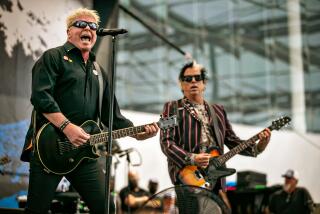Why Joy Division? Henry Rollins examines Jon Savage’s oral history of the post-punk band
Jon Savage’s “This Searing Light, the Sun and Everything Else” documents the formation, brief life and sudden end of the phenomenal Manchester, England, band Joy Division.
Much has been written about this band; some of the sharpest music writers have given their best trying to capture its essence. As brilliant as some of this work is, Joy Division seems to remain in the shadows, just out of reach of critical assessment. Joy Division’s music doesn’t “rock” in the classic sense as much as shudder, roar and convulse. The songs are readings of temperature, light and lack of light. They walk silently for hours on city streets and return alone to small rooms with full ashtrays and no messages on the machine. It’s a fantastically difficult question to answer: Why do you like Joy Division? The more dedicated the listener, the more likely you’ll get an inhaled breath held for a few seconds, an exhale and a shrug.
Savage is one of those aforementioned very talented scribes, who perhaps understands all too well how difficult it would be for any one person to create a clear picture of Joy Division. What better way to tell the story than to ask others to tell its story? By interviewing remaining members and those who bore witness, Savage’s oral history of the band carefully connects the dots.
Joy Division was Peter Hook on bass, Bernard Sumner on guitar, Stephen Morris on drums and Ian Curtis on vocals. The band’s first release, from summer 1978, a four-track 7-inch record called “An Ideal for Living,” could be labeled functionally as post punk, one of the best results of punk music’s exhilarating flash-pot bang. The songs are great but show a band only somewhat in control of its talent. Hearing what came next, you wonder if at that time, the four had any idea of what they were capable of.
The following year, the band released its first full length album, the brilliant “Unknown Pleasures.” None of the demos or surviving live recordings hints at what the band would bring to bear with this record. The music seems uninfluenced by any music that came before it but instead by the sheer fact of existence, the sound of your blood rushing through your veins.
The members of Joy Division were driven to create something of immense beauty, as if there were no other choice.
— Henry Rollins
The band became immensely popular. The group performed live and recorded new material. On May 18, 1980, Curtis took his life at age 23. A month later, in June, perhaps Joy Division’s most well-known song, “Love Will Tear Us Apart,” was released. In July 1980, the band’s second album, “Closer,” came out. Joy Division would reach its peak posthumously. Hook, Morris and Sumner carried on as New Order to great success all over the world.
I became a fan, never having heard “Unknown Pleasures.” Many years ago, I was playing my current favorite record for someone, who said I should cut out the middleman and listen to the band it was desperately trying to emulate: Joy Division. I’m not aware of anyone in any of the bands I was in having any interest in Joy Division’s music. I knew of the band but had heard only “Love Will Tear Us Apart.” Then I remembered that in the remaining space of many of the tapes I had received in trades from a fellow cassette enthusiast, he had put on tracks from Joy Division shows. I listened to them and was knocked out by the incredible intensity of the band. There’s no way you would want to go on after Joy Division.
A key moment for Joy Division happened at a Sex Pistols show at Manchester’s Lesser Free Trade Hall on June 4, 1976. Reportedly attended by fewer than 50 people, the show proved to be quite a night. In the audience were future members of the Fall, Joy Division and two men who would prove to be of great importance to the group: Factory Records partners Tony Wilson and Martin Hannett. The Factory label was almost a perfect reflection of Wilson; rebellious, innovative and fiercely independent. Joy Division — and other post-punk art-bands like A Certain Ratio and the Durutti Column — found great support at Factory.
Post-punk music delivered on punk’s detonation of rock music’s predictability. Joy Division wasn’t the only band that started at some point in the punk din and evolved by leaps and bounds. Gang of Four, Killing Joke, the Fall, the Birthday Party and Wire were a few of the great bands that fell under the post-punk heading. (If you want to know more, the go-to book is Simon Reynolds’ excellent “Rip It Up and Start Again: Postpunk 1978-1984.”) And one of the greatest acts of punk-to-post-punk morphing was John Lydon (a.k.a. Johnny Rotten) going from perhaps the most well known punk band of all time, the Sex Pistols, to the completely different Public Image Limited.
Yet what has baffled many a Joy Division listener is the band’s own evolution; how its members, all novice players, went from rudimentary bashing with songs like “Gutz” and “You’re No Good for Me” in 1977 to utterly brilliant tracks like “Transmission,” “Atmosphere” and “Love Will Tear Us Apart” just a few years later.
We just completely ignored each other, we were all on our own island, and we just made sure that what we were doing sounded great.
— Bernard Sumner
Without Wilson and Hannett, it could be argued, Joy Division’s potential would have been greatly compromised. Wilson believed in the band completely, allowed it to flourish. But in “This Searing Light,” Sumner describes an isolated and workman-like environment at practice, where each player was in his own world. “We were not bouncing off each other,” he says, “we just completely ignored each other, we were all on our own island, and we just made sure that what we were doing sounded great, and we didn’t pay any attention to what the others were doing, not consciously anyway.”
While this might sound like the members didn’t get along, it is a quite Mancunian posture, when you consider that the greater Manchester area was infused with factories, warehouses and remnants of World War II. It’s not surprising that being raised in this environment might engender a somewhat stark outlook and utilitarian work ethic.
“You were always looking for beauty because it was such an ugly place, whether again on a subconscious level,” Sumner says. “I mean, I don’t think I saw a tree till I was about nine. I was surrounded by factories and nothing that was pretty, nothing.”
Manchester bands like Joy Division, the Fall and Buzzcocks were greatly distanced from the outrage and fashion that fueled the London punk scene, a little over 200 miles south, and while their surroundings could be grim, it made for quite a creative setting. In “This Searing Light,” you get the idea that it was a “resist or submit” proposition.“It gave you an amazing yearning for things that were beautiful,” Sumner says, “because you were in a semi-sensory-deprivation situation because you were brought up in this brutal landscape, but then when you did see something or hear something that was beautiful, you would go, ‘Ooh, new experience,’ and really appreciate it.”
Still, how do four young men from the working class, in one of the toughest parts of a tough country, almost suddenly create not only some of the most enduring music from the late 1970s and early 1980s but also easily one of the most astonishing debut albums ever, “Unknown Pleasures”?
In the pages of “This Searing Light,” we get many clues from the testimonies of those in close proximity to the band.
Peter Saville, Factory co-founder and art director, is responsible for the “Unknown Pleasures” cover, one of the most recognizably reworked and repurposed music-related images of the last century. Saville isn’t the originator; it is a found image, part of the materials in a folder given to Saville by the band’s manager, Rob Gretton. There are, no doubt, people all over the world wearing a version of this pulsar spread out on a T-shirt who have no idea what it’s relating to. That being said, if you had to describe “Unknown Pleasures,” the image works perfectly; separate, straight lines randomly disrupted; peaks and valleys and then flat again. Such is life.
I don’t think I saw a tree till I was about nine. I was surrounded by factories and nothing that was pretty, nothing.
— Bernard Sumner
Hannett, who produced “Unknown Pleasures,” was a true visionary. There is no way the album would sound anything like it does without him. At times, Hannett seemed almost dismissive of his young charges: “They were a gift to a producer, because they didn’t have a clue. They didn’t argue.”
Hannett was notoriously idiosyncratic and difficult, and the band members endured him as much as worked with him. Hannett was obsessed with isolating and manipulating sound — the studio was his world; Joy Division was just hanging out in it for awhile.
“The studio was Martin’s,” says Morris, “and when you were in the studio you were working for Martin and his whims. There was an awful lot of pot smoked: whether Martin was completely stoned or did have a different outlook on what he wanted, he would be obtuse. He wouldn’t say to you, ‘I want you to do it like this.’ It was, ‘Great, do it again but more cocktail party’ or ‘a bit more yellow.’ Whether it was pot or whether it was the Zen school of production, it was definitely interesting, because he turned us on to the studio being a musical instrument.”
Kevin Cummins, the great photographer who took some of the most recognizable images of Joy Division, was witness to the band’s rapid growth and the mesmerizing stage presence of Curtis. “It always felt dangerous, because you always felt he was slightly out of control, and I’d not really experienced that with any other band,” Cummins says. “I’d seen the Clash and the Jam and all these bands, and I never felt that they were more than the sum of their parts. But with Ian, it was dangerous. The only other person who was that dangerous onstage was Iggy Pop.”
These are some of the nearly 40 people from Joy Division’s inner circle whose accounts Savage, who was also there at the time, has deftly woven into an almost detective-style MRI of the band and the forces and factors that formed it. Almost particle by particle, from descriptions of Manchester’s industrial beginnings to the area’s cultural void, Savage makes you understand that the members of Joy Division were driven to create something of immense beauty, as if there were no other choice.
The music seems uninfluenced by any music that came before it but instead by the sheer fact of existence, the sound of your blood rushing through your veins.
— Henry Rollins
As matter-of-fact as the interviews are, and as carefully as Savage has laid out his case, the “how” of the band’s amazing music is all but impossible to put your finger on. Liz Naylor, a writer at the Manchester fanzine City Fun, captures the band’s close distance: “My thing about Joy Division is that they’re an ambient band almost: you don’t see them function as a band, it’s just the noise around where you are.”
It’s not up for debate. Joy Division was one of the most original bands of the last century and an influence on countless others that came afterward. “This Searing Light, the Sun and Everything Else” brings us a little closer to understanding the band and its incredible music. But still, even after the careful examination of almost every aspect of the band’s brief existence, its music still lurks deep in phenomenon and shadow.
::
“This Searing Light, the Sun and Everything Else: Joy Division: The Oral History”
Jon Savage
Faber & Faber Social: 272 pp., $28
Rollins is an L.A.-based writer and radio show host.
More to Read
Sign up for our Book Club newsletter
Get the latest news, events and more from the Los Angeles Times Book Club, and help us get L.A. reading and talking.
You may occasionally receive promotional content from the Los Angeles Times.






